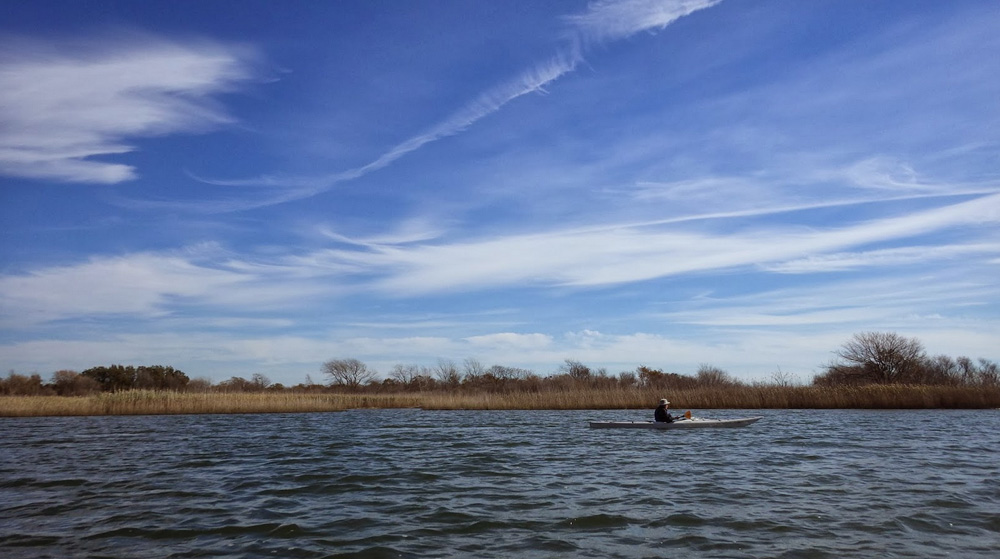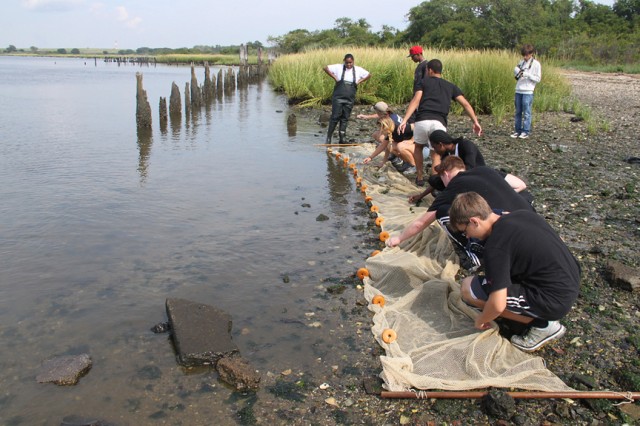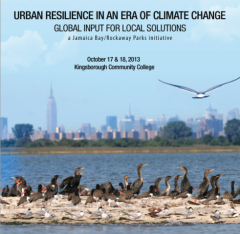
In late October the National Park Service, New York City Department of Environmental Protection, New York City Department of Parks & Recreation, the City University of New York and the Natural Areas Conservancy came together to host Urban Resilience in an Era of Climate Change: Global Input for Local Solutions, a two-day symposium at the waterfront location of Kingsborough College in Brooklyn.
Experts from around the globe gathered to discuss the impacts of Hurricane Sandy on the bay’s ecosystem and watershed, which is home to 880,000 New Yorkers. The goal is to develop strategies that might work both for the New York region and for coastal populations everywhere that face rising seas and larger storms.
[pullquote align=”right”]Creating the first center for the study of resilience in the world.[/pullquote]
A major part of the conversation focused on the future Jamaica Bay Science and Resilience Institute, a CUNY initiative that was announced earlier this summer by Mayor Bloomberg, and that features funding from the Rockefeller Foundation. Rockefeller has an ongoing commitment to the study and practice of urban resilience, and their August announcement sums up the foundation’s goals in Jamaica Bay:
“The Jamaica Bay Science and Resilience Institute is our first investment in a bricks and mortar facility for resilience — that’s because, quite frankly, it will be the first center of its kind anywhere in the world. And it is an idea whose time has come.
At the Rockefeller Foundation we help bring together scientists and researchers thinking about resilience, with practitioners and policymakers who can translate those findings to concrete action. We believe this Institute will play an important role in ensuring those efforts are coordinated, comprehensive and streamlined, not only for the benefit of those living in Jamaica Bay, but can be a model for other likeminded institutions that can impact billions of people living in fragile urban ecosystems around the world.” 1
Dr. William Solecki, director of the CUNY Institute for Sustainable Cities and advisor to City Atlas, has been named interim director for the Jamaica Bay institute.
The two day schedule of presentations offered the opportunity for local researchers to discuss regional developments and enter into dialogue with counterparts confronting similar coastal resilience issues across the nation and the world.
Following is a brief recap of some of the discussions at the symposium:
Local research and restoration efforts in Jamaica Bay

Dan Mundy Jr. of Jamaica Bay Ecowatchers and Don Riepe of the American Littoral Society presented successful examples of restoring the marshes at Rulers Bar and Black Wall Island in the bay, and spoke of the importance of community involvement in hands-on projects, and the effectiveness and long-term benefits of youth participation.
Chris Pickerell, Director of the Cornell Cooperative Extension of Suffolk County Marine Program and Greg J. Rivera, Aquaculture Specialist, both described how failures in wetland restoration are not entirely failures. Instead, shortcomings should be seen as indicators of what not to do in the future, serving as a learning process; that failures in planting eel grass and restoring oyster populations should not deter ecologists in the Jamaica Bay, but instead drive them forward towards new techniques or realizations concerning the ecosystem.
Research conducted by Christopher Gobler, Professor of the School of Marine and Atmospheric Sciences at Stony Brook University, found that algae levels in the Bay hindered the growth of other marine life. Algae growth depended on movement, or stagnation, of water: in areas where water had been frequently flushed, algae growth was constrained. Gobler suggests that future ecosystem restoration projects should focus on planting within areas of high flushing rates, as well as working towards new ways to increase circulation in more stagnant areas in the Bay.
Philip Orton, Research Scientist at the Stevens Institute of Technology, shared a presentation on filling, or “shallowing,” the bottom of waterways to provide flood protection. His research shows that certain shallowing strategies can help create “bottle-neck” effects, channeling storm surges along enclosed waterways and inlets to less vulnerable areas. During model simulations, shallowing paired with sufficient wetland coverage reduced flooding substantially. Implementation could be effective, but has the trade-off of losing depth for shipping lanes, and the cost of engineering the bottom with sand.
Pinar Balci, Director of the DEP Bureau of Environmental Planning and Analysis, introduced DEP’s comprehensive and efficient City-wide Climate Analysis Framework, which is broken up into Climate Analysis, Risk Analysis (i.e. building-level vulnerability and asset-level vulnerability assessments, facilities at-risk of storm surge inundation), and Adaptation Analysis (ex. Levels of adaptation regarding at-risk facilities to storm surge inundation from greatest to least urgency: elevate equipment, flood proof equipment, seal building, construct barrier, sandbag temporarily, install back-up power).
[pullquote align=”left”]For DEP, $350 million in green infrastructure could save $3+ billion in damage over 50 years.[/pullquote]
By using this analysis framework, the DEP determined that by investing in resilient green infrastructure and New York Harbor and wetlands restoration projects, roughly $350 million in initial investments would save the city an estimated $1.1 billion of vital infrastructure and $2.5 billion in emergency response costs over the next 50 years.
International inputs
Henk Ovink, a native of the Netherlands, now chair of HUD’s Hurricane Sandy Rebuilding Task Force, made an interesting reference to the odds of New York City encountering another 100-years flood by comparing the frequency of such to a game of cards. Ovink noted that the odds of a 100-years flood is actually greater than being dealt a straight in poker – a hand that is not exactly rare.
Echoing the words of Pinar Balci, Ovink stressed the importance of economic resilience and that the best interest of NYC is to invest today so that the city may be prepared and resilient to storm damages and their enormous costs tomorrow.
Professor of Civic and Environmental Engineering at Duke, Marco Marani, having much experience in flood research in Venice, Italy, urged the need to create options in advance of future events — that “if we are unable to bring back the marshes, what then will we do? And what exactly are we trying to achieve?” …simply, what is NYC’s “Plan B”?
Realizing the possibility of failed marsh reproduction and rising sea levels, Eric Klinenberg, Director of the Institute for Public Knowledge at NYU, built upon Marani’s idea by addressing the need to develop resiliency designs that allow the water in, rather than fighting a losing battle of keeping the water out.
Glenn Stewart, an Urban Ecology Professor hailing from New Zealand, insisted that “we need to make decisions that people can digest. The bloke down the road has no idea what resiliency is, but all he wants to know is that his house will still be there the next day.”
Ways forward
Bruce A. Stein, Director of Climate Change Adaptation at the National Wildlife Federation, set the tone of the 2-day event by honoring the hockey demi-god, Wayne Gretzky, in his famous quote, “I skate to where the puck is going to be, not to where it’s been,” and how this idea of early adaptation and preparedness needs to be applied to the climate change resilience agenda.
Lara J. Hansen, Chief Scientist and Executive Director at EcoAdapt, expanded on this theme by making the assertion that extreme climate disaster scenarios (i.e. a “Noah’s Ark flood,” nuclear winter, catastrophic heat waves, etc.) will come to pass eventually at some time or another. By realizing this unavoidable truth, she suggests that waterfront planning should focus on preparation and adaptation to such radical scenarios, rather than resorting to reactionary planning – or planning which tends to confront these problems after the fact.
Brett F. Franco, Assistant Professor of the Aquatic Research and Environmental Assessment Center at Brooklyn College, spoke of the need for increased cohesion and more efficient collaboration between departments and agencies (NPS – DEP) as to avoid any overlap, and therefore wasted time and resources.
Biohabitat’s Water Resources Engineer, Ted Brown called towards efficient adaptation in two directions: “Not only do our ecosystems have to adapt, but our designers must adapt as well.” NYC planners, environmentalists and ecologists must be able to appreciate the realities regarding the Jamaica Bay ecosystem, as undesirable as they may be at times.
Many of the themes and ideas for a way forward were echoed over the two days, strengthening the sense that there is a general consent about priorities among experts – both from the private and public sectors.
The Jamaica Bay Science and Resilience Institute
The segment of the symposium on the Jamaica Bay Science and Resilience Institute opened the talk to suggestions and strategies for the institute. Ideas include recognizing research that covers local, regional, national, and international levels; association with external institutions (NGOs, not-for-profits, etc.), constant contact and communication with these institutions as to avoid overlapping parallels in research, reestablishment of trust with local communities, the importance of vernacular design and knowledge, the need to build a shared conceptual framework and one that is more flexible and able to evolve, and the need for multiple sources of revenue, with at least one permanent source.